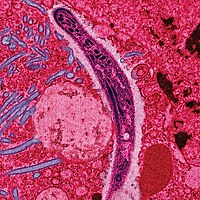
Effect of norepinephrine treatment on Haemonchus contortus and its excretory products
Sign Up to like & getrecommendations! Published in 2019 at "Parasitology Research"
DOI: 10.1007/s00436-019-06230-z
Abstract: Haemonchus contortus is a highly pathogenic gastrointestinal nematode of small ruminant animals. In modern intensive farming, livestock often suffer from different types of stress. However, whether host stress hormones influence H. contortus infection is largely… read more here.
Keywords: treatment; treated contortus; haemonchus contortus; effect norepinephrine ... See more keywords

Effects of Ferula asafetida, closantel, albendazole, oxfendazole, and ivermectin against Haemonchus contortus in goats and sheep.
Sign Up to like & getrecommendations! Published in 2022 at "Tropical animal health and production"
DOI: 10.1007/s11250-022-03111-z
Abstract: BACKGROUND Haemonchosis is a fatal disease of small ruminants caused by the parasite Haemonchus contortus (H. contortus). The most common drugs used in the treatment of H. contortus include albendazole, oxfendazole, and ivermectin. However, as… read more here.
Keywords: oxfendazole ivermectin; closantel; treatment; ferula asafetida ... See more keywords

Combined Molecular and Lectin Binding Assays to Identify Different Trichostrongyle Eggs in Feces of Sheep and Goats from Egypt.
Sign Up to like & getrecommendations! Published in 2020 at "Acta parasitologica"
DOI: 10.1007/s11686-020-00287-y
Abstract: BACKGROUND Trichostrongyles are common causes of parasitic gastroenteritis in sheep and goats worldwide. Accurate identification of these nematodes to the genus and/or species level is important for therapy selection and control strategies. In the present… read more here.
Keywords: lectin binding; lectin; trichostrongyle eggs; sheep goats ... See more keywords

In Vitro Nematocidal Effect and Anthelmintic Activity of Artemisia cina Against Haemonchus contortus in Gerbils and Relative Expression of Hc29 Gene in Transitional Larvae (L3-L4).
Sign Up to like & getrecommendations! Published in 2021 at "Acta parasitologica"
DOI: 10.1007/s11686-021-00364-w
Abstract: PURPOSE (1) To assess the in vitro activity of Artemisia cina against Haemonchus contortus L3 (HcL3) and in transitional (L3-L4) larvae (HcTrL3-L4); (2) to quantify the relative expression of the Hc29 gene in HcTrL3-L4 exposed… read more here.
Keywords: hc29 gene; relative expression; contortus; cina ... See more keywords

Effects of Acacia mearnsii supplementation on nutrition, parasitological, blood parameters and methane emissions in Santa Inês sheep infected with Trichostrongylus colubriformis and Haemonchus contortus.
Sign Up to like & getrecommendations! Published in 2019 at "Experimental parasitology"
DOI: 10.1016/j.exppara.2019.107777
Abstract: Gastrointestinal nematodes are a main problem for ruminant production, reducing animal performance and increasing environmental impact per unit of animal product generated. Tannin supplementation may lead to positive results regarding aspects such as parasitic infections… read more here.
Keywords: supplementation; blood parameters; colubriformis; blood ... See more keywords

Mating barriers between genetically divergent strains of the parasitic nematode Haemonchus contortus suggest incipient speciation.
Sign Up to like & getrecommendations! Published in 2019 at "International journal for parasitology"
DOI: 10.1016/j.ijpara.2019.02.008
Abstract: Haemonchus contortus, in common with many nematode species, has extremely high levels of genetic variation within and between field populations derived from distant geographical locations. MHco10(CAVR), MHco3(ISE) and MHco4(WRS) are genetically divergent H. contortus strains,… read more here.
Keywords: mhco10 cavr; mhco4 wrs; contortus; mhco3 ise ... See more keywords

The developmental phosphoproteome of Haemonchus contortus.
Sign Up to like & getrecommendations! Published in 2019 at "Journal of proteomics"
DOI: 10.1016/j.jprot.2019.103615
Abstract: Protein phosphorylation plays essential roles in many cellular processes. Despite recent progress in the genomics, transcriptomics and proteomics of socioeconomically important parasitic nematodes, there is scant phosphoproteomic data to underpin molecular biological discovery. Here, using… read more here.
Keywords: developmental phosphoproteome; parasitic nematode; haemonchus contortus; contortus ... See more keywords

Comparative study of transcription profiles of the P-glycoprotein transporters of two Haemonchus contortus isolates: susceptible and resistant to ivermectin.
Sign Up to like & getrecommendations! Published in 2020 at "Molecular and biochemical parasitology"
DOI: 10.1016/j.molbiopara.2020.111281
Abstract: The objective of this study was to analyze the mRNA transcription levels of ten functional genes of P-glycoproteins (P-gp) in free life stages, eggs and infective larvae (L3) and in endoparasitic stages, fourth larval stage… read more here.
Keywords: isolate; haemonchus contortus; ivm; contortus ... See more keywords

Haemonchus contortus infection induces a variable immune response in resistant and susceptible Pelibuey sheep.
Sign Up to like & getrecommendations! Published in 2021 at "Veterinary immunology and immunopathology"
DOI: 10.1016/j.vetimm.2021.110218
Abstract: The immune response and phenotypic characteristics of Pelibuey lambs were analysed after the induction of a Haemonchus contortus trickle infection. Male lambs (n = 29; 20 kg live weight) were infected with 100 H. contortus infective larvae per… read more here.
Keywords: epg; expression; immune response; resistant susceptible ... See more keywords

Phenotypic expression of parasite susceptibility to Haemonchus contortus in Pelibuey sheep.
Sign Up to like & getrecommendations! Published in 2017 at "Veterinary parasitology"
DOI: 10.1016/j.vetpar.2017.04.015
Abstract: The objective of this study was to determine if the mean faecal egg count (FEC) from a first experimental Haemonchus contortus infection could be used to classify parasite-naïve Pelibuey hair sheep as parasite-resistant high responders… read more here.
Keywords: stage iii; high responders; infection; low responders ... See more keywords

High-throughput identification and quantification of Haemonchus contortus in fecal samples.
Sign Up to like & getrecommendations! Published in 2019 at "Veterinary parasitology"
DOI: 10.1016/j.vetpar.2018.11.017
Abstract: Haemonchus contortus are gastrointestinal nematodes of the family Trichostrongylidae that naturally infect small ruminants while grazing, posing a risk to both animal health and farm profitability. Current diagnostics depend on exacting lab techniques, including manual… read more here.
Keywords: fecal samples; identification quantification; haemonchus contortus; quantification ... See more keywords